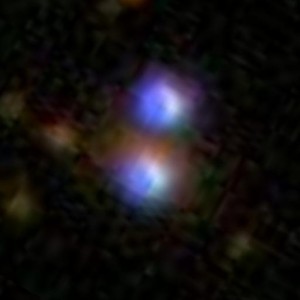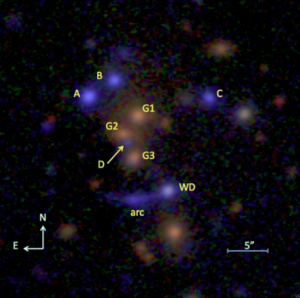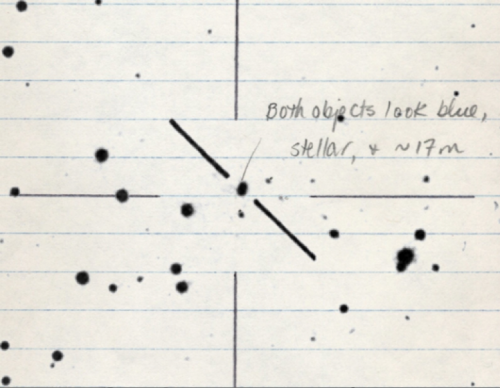A couple of months ago astronomers reported the discovery of an unusual six-component “gravitational lens”—six images of the same object coming at us from slightly different positions in the sky. As light traveling across the universe passes a large mass, the gravity from the mass will serve as a kind of lens, bending the rays. In the case of SDSS J2222+2745, the light from a quasar (the signature blast of energy that results from matter falling into a black hole at the center of a galaxy) passed through a cluster of hundreds of galaxies, getting diverted this way and that, until six images of the quasar emerged. For astronomers such as myself, the detection of this particular gravitational lens is important for several reasons. But for me, the detection of any gravitational lens isn’t just important. It’s personal.
Gravitational lensing is a consequence of Einstein’s general theory of relativity, which he published in 1916, but not until 1979 did astronomers actually report the discovery of a gravitational lens. Three years earlier, however, I might have been the first person to see such an object in an astronomical photograph.
In the summer of 1976, I worked for a newly minted Ph.D., Richard Porcas, at the National Radio Astronomy Observatory in Charlottesville, Virginia. I wasn’t an astronomer then, just an undergraduate on a summer internship. I wasn’t even sure I’d like to be an astronomer. But the position gave me a chance to find out what astronomical research was all about. Porcas assigned me a task that didn’t require me to have a background in astronomy: studying the positions of pinpoint sources of radio waves that had been observed at the Jodrell Bank Observatory in England, and trying to locate their optical counterparts in photographs from the Palomar Sky Survey. One pair of radio sources in particular caught my attention.
“Both objects look blue, stellar,” I recorded. I also noted that they were very nearly the same brightness—“~ 17m,” meaning 17th magnitude, much fainter than the eye can see even with a good amateur telescope.
It didn’t occur to me that they might be two images of the same object. Over the next couple of years, however, the similarity between the two objects caught the attention of bona-fide astronomers. During their research, they apparently found my careful notes from that summer (above). In 1979, D. Walsh, R. F. Carswell, and R. J. Weymann published “0957 + 561 A, B: twin quasistellar objects or gravitational lens?” The answer: it was a gravitational lens (below).
 For astronomers, a gravitational lens performs two important functions: It bends light; it magnifies light. Here’s how:
For astronomers, a gravitational lens performs two important functions: It bends light; it magnifies light. Here’s how:
When astronomers look at the sky, they record the direction from which the light arrives. If a light ray has been bent even slightly, it appears to come from the “wrong” location—not where the object actually is. The amount of bending depends on the mass: Bigger masses redirect the light more acutely. Every object—any matter or energy—bends light this way, but in daily life, such deflections are far, far too tiny to notice. On the scale of the universe, though, if a sufficiently bright object (such as a quasar or galaxy) is about twice as far away from us as a lens (such as a cluster of galaxies), a good telescope could actually see multiple lensed images of the source spread out over an area comparable to the lens itself.
Gravitational lensing also intensifies the light from the background source of light. Basically, because light that otherwise would have missed the Earth is sent our way, the lensed object is brighter than it would appear were no lens in the way.
This combination of factors explains why gravitational lenses are sometimes called nature’s telescope: They stretch the images, making them bigger, hence more easily studied, and they magnify the light from background quasars or galaxies, making them brighter. It’s as if you made your telescope 10 times larger—that is, you made the diameter of the mirror three times wider—for free.
 In the case of SDSS J2222+2745, the six-component lens announced in August, the A, B, and C images followed a highly curved path and so are brighter than the fourth (D), fifth and sixth images of the lensed quasar. Those faint images are sometimes difficult to see because the cluster galaxies (G1, G2, G3) outshine them. Indeed, a seventh image is expected behind galaxy G2; gravitational lenses should almost always produce an odd number of images. Perhaps it will be seen by the Hubble Space Telescope, which because of its sensitivity and spatial resolution is ideal for this purpose.
In the case of SDSS J2222+2745, the six-component lens announced in August, the A, B, and C images followed a highly curved path and so are brighter than the fourth (D), fifth and sixth images of the lensed quasar. Those faint images are sometimes difficult to see because the cluster galaxies (G1, G2, G3) outshine them. Indeed, a seventh image is expected behind galaxy G2; gravitational lenses should almost always produce an odd number of images. Perhaps it will be seen by the Hubble Space Telescope, which because of its sensitivity and spatial resolution is ideal for this purpose.
All quasars brighten and dim over time, so each of the six (or seven) images will also brighten and dim over time. But because the light in each of the images follows a different path around or through the cluster, the bright and faint stages will appear to occur at different times in each image. The time delays are a sensitive probe of the mass distribution in the lens, and once astronomers understand the distribution of that mass, they will be able to study the patch of distant universe—the neighborhood of the lensed quasar—in extraordinary detail.
These days, anyone can help find gravitational lenses: A citizen science project called SpaceWarps wants you! But in 1976, during my first foray into the fun of astronomy, nobody had yet identified even one gravitational lens. Louis Pasteur reportedly said, “Fortune favors the prepared mind.” Mine, alas, was not.
* * *
Meg Urry is president-elect of the American Astronomical Society as well as the Israel Munson Professor of Physics and Astronomy at Yale University, where she directs the Yale Center for Astronomy and Astrophysics. Her research group studies the supermassive black holes that live in the centers of most galaxies, using great observatories like Hubble, Spitzer, Chandra, XMM-Newton, and Keck. She thinks being an astrophysics professor is the luckiest thing that ever happened to her since she won the lottery for a 3-foot-tall stuffed rabbit toy in second grade.

Did you actually hand-draw that chart? Wow. And I thought that my grampa stories about taking polaroid pictures of POSS prints were paleolithic enough…
Thanks for putting your story on Last Word On….
Is the best explanation I’ve read of gravitational lensing. I hope you get recognition for your “discovery”.